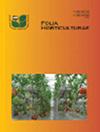Agronomic traits, secondary metabolites and element concentrations of Lavandula angustifolia leaves as a response to single or reiterated drought stress: How effective is the previously experienced stress?
IF 2.2
4区 农林科学
Q2 HORTICULTURE
引用次数: 0
Abstract
Abstract In nature, plants are constantly challenged by an array of drought episodes, which critically affect the distribution of the plants. The drought episodes might occur recurrently, so the plants endure drought by adjusting and shifting their metabolisms. The impacts of subjecting plants to drought stress have been widely investigated, but reports on how reiterated drought stress affects the plants are limited. The present study was designed to investigate the response of lavender, a reputed medicinal and aromatic plant, against single drought, recovery and reiterated drought stress at greenhouse conditions. In this regard, the experimental design was based on three cycles of 11 days of drought by withholding water, followed by subsequent periods of 6 days of recovery, and then double-stressed and single-stressed periods. As expected, the present findings revealed that single stress decreased the fresh and dry weights of the leaf, stem and root. Reiterated drought stress caused critical reductions in the fresh weight of the leaf, stem and root, while the dry weight of stem and root were not significantly affected. Of the estimated traits, only the dry weight of leaf increased with reiterated drought stress. The mineral status of the leaves was adversely affected with single stress, but the effects of recovery and reiterated stress were not in accordance with the improvement in water contents of the leaf and soil. Regarding essential oil compounds, eucalyptol, camphor and endo-borneol were predominant. Single and reiterated drought stress increased camphor percentage, while recovery and full irrigation decreased the percentage. Endo-borneol was decreased under single stress, but reiterated stress increased the percentage of the compound. Considering the phenolic acids, stressed and non-stressed groups were well discriminated and hence, phenolic acids might be useful as good indicators of the stress response in lavender.单次或多次干旱胁迫对薰衣草叶片农艺性状、次生代谢物和元素浓度的影响:先前经历的干旱胁迫有多有效?
摘要在自然界中,植物不断受到一系列干旱事件的挑战,这些干旱事件严重影响了植物的分布。干旱事件可能会反复发生,因此植物通过调整和改变新陈代谢来忍受干旱。对植物遭受干旱胁迫的影响进行了广泛的研究,但关于反复干旱胁迫如何影响植物的报道有限。本研究旨在研究薰衣草,一种著名的药用和芳香植物,在温室条件下对单一干旱、恢复和反复干旱胁迫的反应。在这方面,实验设计基于三个周期,即11天的干旱,蓄水,然后是6天的恢复期,然后是双重胁迫期和单一胁迫期。正如预期的那样,目前的研究结果表明,单一胁迫降低了叶片、茎和根的鲜重和干重。反复干旱胁迫导致叶片、茎和根的鲜重显著减少,而茎和根干重没有受到显著影响。在估计的性状中,只有叶片的干重随着重复干旱胁迫而增加。单一胁迫对叶片的矿质状态有不利影响,但恢复和重复胁迫的效果与叶片和土壤含水量的改善不一致。精油类化合物以桉树醇、樟脑和龙脑为主。单一和重复干旱胁迫增加了樟脑的百分比,而恢复和充分灌溉降低了百分比。单次胁迫下内源性冰片含量降低,但重复胁迫使复合物的含量增加。考虑到酚酸,应激组和非应激组得到了很好的区分,因此,酚酸可能是薰衣草应激反应的良好指标。
本文章由计算机程序翻译,如有差异,请以英文原文为准。
求助全文
约1分钟内获得全文
求助全文
来源期刊

Folia Horticulturae
Agricultural and Biological Sciences-Horticulture
CiteScore
3.40
自引率
0.00%
发文量
13
审稿时长
16 weeks
期刊介绍:
Folia Horticulturae is an international, scientific journal published in English. It covers a broad research spectrum of aspects related to horticultural science that are of interest to a wide scientific community and have an impact on progress in both basic and applied research carried out with the use of horticultural crops and their products. The journal’s aim is to disseminate recent findings and serve as a forum for presenting views as well as for discussing important problems and prospects of modern horticulture, particularly in relation to sustainable production of high yield and quality of horticultural products, including their impact on human health.
 求助内容:
求助内容: 应助结果提醒方式:
应助结果提醒方式:


